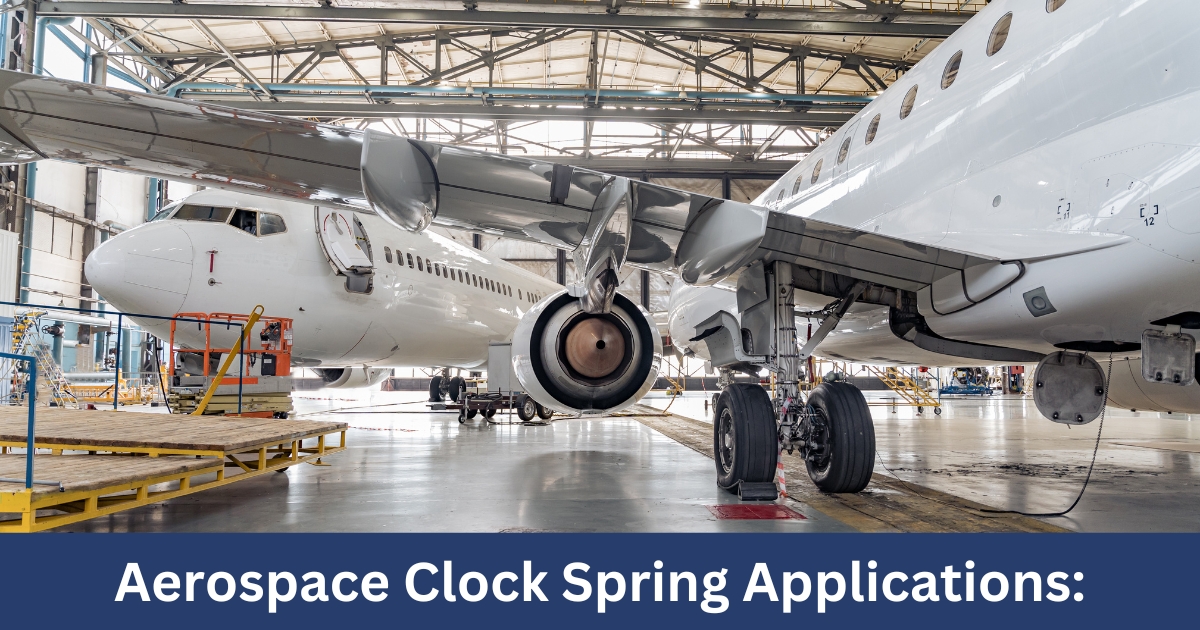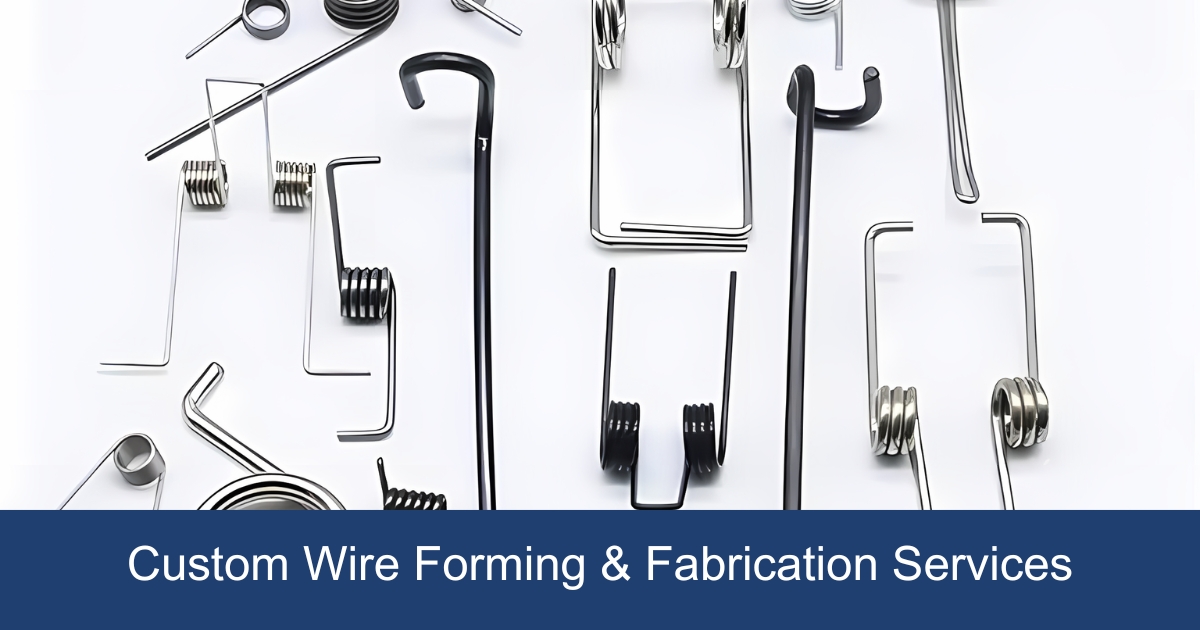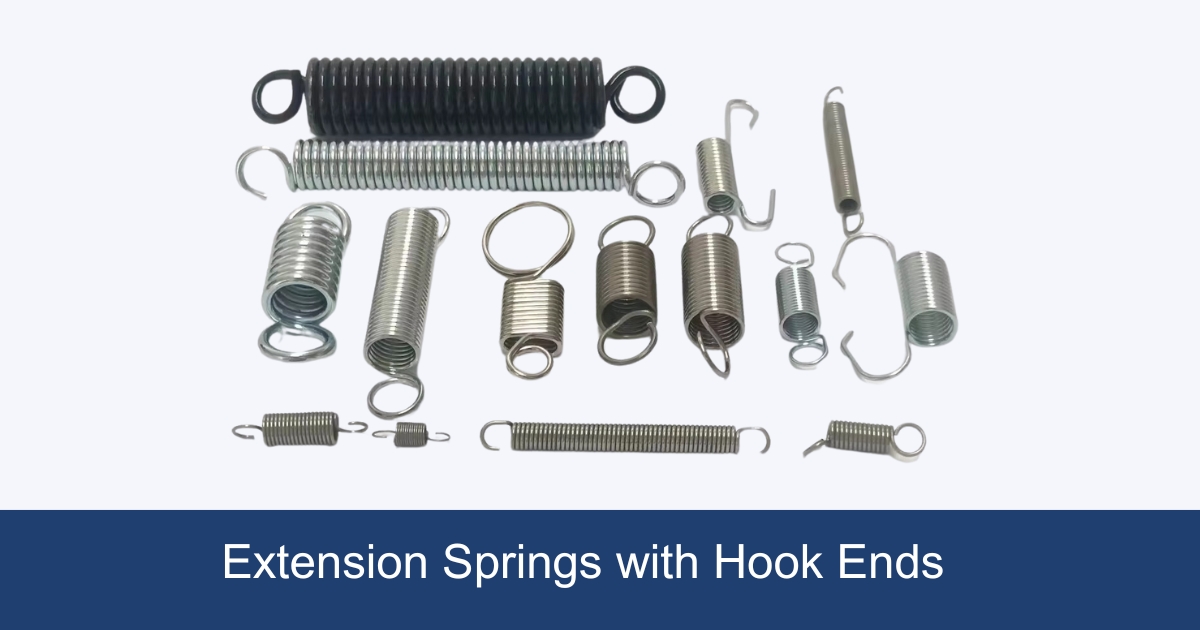Springs, integral components in a multitude of applications, perform crucial functions by operating under compressive load, tensile load, or torque. Their design principles, based on mechanics and physics, such as linear springs, illustrate the force-extension proportionality that underpins the functionality of various types of springs. From the ubiquitous extension springs, used in nearly every industrial sector, to specialized titanium springs and variable rate springs that adapt progressively or abruptly, the versatility in the materials like stainless spring steel and design of springs underscores their critical role in modern technology and machinery.
This article will navigate through the comprehensive landscape of springs, detailing the myriad types including torsion springs, coil springs, and leaf springs, among others, and their distinct uses across industries. It will delve into the specifics of each category, such as compression springs and torsion springs, and explore the applications of less common variants like constant force springs and flat springs.
Compression Springs

Compression springs, known for their versatility and widespread use, play an integral role in a myriad of applications. These open-coil helical springs are specifically designed to oppose compression along the axis of the wind, making them a staple in both industrial and consumer products. Here’s a closer look at the various aspects and uses of compression springs:
- Shapes and Designs:
- Standard: All coils are equally spaced; the most common type found in everyday items.
- Conical: Pyramid-shaped, ideal for limited spaces due to their ability to compress to a nearly flat state.
- Barrel: Characterized by a larger middle diameter, these springs are designed to save space and prevent buckling.
- Hourglass: With a smaller middle diameter, they offer high stability and are suitable for compact applications.
- Variable Windings: These springs do not have an equal distance between coils, allowing for a more tailored force response.
- Material Considerations:
- Music Wire: A high carbon steel wire, known for its high strength and flexibility.
- Stainless Steel 302: Offers corrosion resistance with slightly less strength compared to music wire.
- Nickel Alloys: Used for extreme temperatures or corrosive conditions, and for their non-magnetic properties.
- Common Applications:
- Automotive: From the comfort of seats to the suspension that absorbs road shocks.
- Medical Devices: Utilized in a wide range of equipment, from inhalers and syringes to more complex machinery.
- Everyday Items: Found in pens, locks, and even the comfortable bounce in mattresses and sofas.
Compression springs are designed to store mechanical energy when compressed, making them one of the most efficient energy storage devices available. Their ability to absorb a significant amount of potential force and then return to their original shape is a key feature that is leveraged in countless applications. Whether it’s the smooth operation of a ballpoint pen, the reliable performance of vehicle suspensions, or the critical functionality in medical devices, compression springs are an indispensable component in the design and manufacture of a vast array of products.
Extension Springs

Extension springs, also known as tension springs, play a pivotal role in a wide array of applications by creating resistance against a pulling force. Their design, consisting of tightly wound coils with loops or hooks at each end, enables them to attach separate components and work to bring them closer together. This section delves into the diverse uses and critical aspects of extension springs:
- Key Uses and Applications:
- Garage Doors: Mitigate the strength needed to lift or close heavy doors, making them easier to operate.
- Trampolines: Provide flexibility and bounce, with the number of springs directly affecting the bounciness.
- Toys: Utilized in windup toys and pinball machines to enable fast motion or throwing actions.
- Household and Industrial Equipment: Essential in devices like vise-grip pliers and washing machines, where they hold components in place or absorb energy to prevent damage.
- Medical Devices and Vehicles: Found in stretchers, surgical lights, and farm vehicles for various functional needs.
- Design and Customization:
- Initial Tension: This can be adjusted to meet specific load requirements, affecting how the spring operates under force.
- End Attachments: Designs include hooks, eyes, or other geometries to connect to components. Customizable ends (e.g., threaded inserts, extended twist loops) allow for varied applications.
- Continuous Length: These springs can be cut to desired lengths by users for specific needs, showcasing their versatility.
- Key Parameters for Design:
- Dimensions: Including Outside Diameter, Inside Diameter, Wire Diameter, Free Length, and Extended Length.
- Performance Metrics: Spring Rate and Maximum Load determine the spring’s behavior under force.
Through their varied applications, from facilitating the operation of garage doors to the delicate bounce in baby carriages, extension springs exemplify the blend of precision engineering with practical functionality. Their ability to absorb and store energy, coupled with the flexibility in design and customization, underscores their importance across different sectors, including automotive, medical, and consumer goods.
Torsion Springs
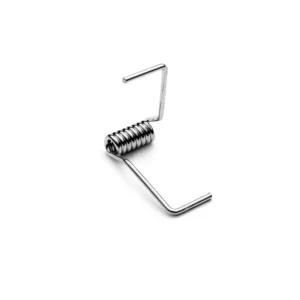
Torsion springs are essential mechanical components that utilize torque or a twisting force to operate. These springs are crucial in a variety of applications, from simple household items to complex industrial machinery. Their functionality is based on exerting a rotational force when twisted along their axis. This unique mechanism allows torsion springs to store and release energy, making them indispensable in many mechanical systems.
- Materials and Design Adjustments:
- Materials: Primarily made from high carbon steel or chrome silicone, torsion springs are designed to withstand environmental abuse and provide exceptional strength. Stainless steel and other alloys are also used for specific applications requiring corrosion resistance or specific temperature tolerances.
- Customization: The properties of torsion springs, such as wire diameter, outer diameter, and the number of coils, can be varied to meet the requirements of different applications. This high level of customization ensures that torsion springs can be tailored to provide the necessary torque for various mechanical needs.
- Applications Across Industries:
- Automotive: In the automotive sector, torsion springs are found in suspension systems, chassis, automotive valves, clutches, and gear shifters. Their ability to provide high torque makes them suitable for these critical components.
- Medical Equipment: The medical industry benefits from the precision and reliability of torsion springs in devices such as medical immobilization devices, hospital beds, dental applications, and wheelchair lifts.
- Household and Consumer Products: From door hinges that allow doors to return to their original position to the clamping action in clothespins and the safety mechanism in car seatbelts, torsion springs are integral to the functionality of many everyday items.
- Industrial and Safety Equipment: Torsion springs are used in rear trailer doors and gates, aiding in lifting by offsetting most of the weight. Additionally, they are found in torsion spring-loaded camming devices used as rock climbing protection equipment, showcasing their versatility and importance in safety applications.
Torsion springs stand out for their durability and long lifespan, attributed to their ability to endure repeated twisting and untwisting without succumbing to fatigue failure. This resilience, combined with their adaptability and wide range of applications, underscores the critical role torsion springs play in modern mechanical design and engineering. Their ongoing evolution in materials and design continues to expand their utility across an ever-growing spectrum of industries and applications.
Garter Springs

Garter springs, a unique subset of helical springs, are ingeniously designed with their ends connected to form a complete circle. This distinctive structure enables them to exert a powerful radial force, making them an essential component in applications requiring consistent, circular pressure. The design and functionality of garter springs set them apart from other types of springs, as they offer a solution to mechanical challenges that require forces to be applied in a radial direction.
Key Attributes:
- Form: Circular, with connected ends
- Force Application: Radial, providing uniform pressure in a circular direction
- Primary Use: In applications where space is limited and a continuous force is needed around a circumference
For those looking into incorporating garter springs into their designs or needing replacements for existing applications, Zigoal offers comprehensive solutions. With a focus on precision and quality, they provide a range of garter springs tailored to meet specific industrial requirements. Contacting them is straightforward and can lead to valuable insights on how these springs can be integrated into various mechanical systems.
Contact Information:
- Zigoal Spring
- Email: [email protected]
- Services Offered: Custom garter spring design and manufacturing, consultation for application-specific needs
This exploration into garter springs underscores their significance in the broader spectrum of helical springs. Their ability to apply radial force efficiently makes them indispensable in scenarios where such a force distribution is critical.
Helical Springs
Helical springs, often recognized for their classic coil shape, are integral components in countless applications due to their versatility and efficiency in storing mechanical energy. These springs can be stretched or compressed, and they return to their original shape when the load is removed, demonstrating excellent durability and resilience. Here’s a closer look at the key aspects of helical springs:
- Types of Helical Springs:
- Compression Helical Springs: Designed to operate with a compressive load, making them ideal for applications requiring a force to be applied in order to compress the spring.
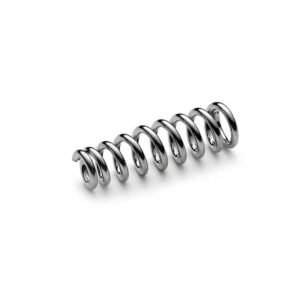
-
- Extension Helical Springs: These springs are designed to operate under tension, stretching to a specific length when a load is applied and returning to their original shape once the load is removed.

-
- Torsion Helical Springs: Engineered to withstand twisting force or torque; these springs store and release angular energy.
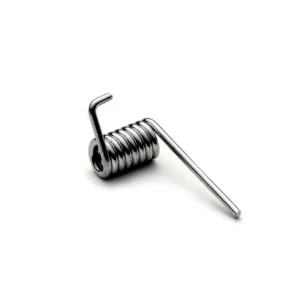
- Material Selection:
- High Carbon Steel: A common choice for its balance of flexibility and strength.
- Stainless Steel: Offers corrosion resistance, making it suitable for harsh environments.
- Nickel-based Alloys: Ideal for extreme temperatures and corrosive conditions.
- Applications Across Various Industries:
- Automotive: Helical springs are used in suspension systems, providing the necessary cushioning effect to absorb road shocks.
- Manufacturing Machinery: These springs play a crucial role in machinery where precise force and motion control is required.
- Electronics: In electronic devices, small helical springs are used for button contacts and battery connections, ensuring reliable conductivity and performance.
The adaptability of helical springs to various loads and environments, coupled with their availability in a wide range of materials and configurations, makes them a fundamental component in mechanical design. Their application in industries from automotive to electronics underscores their importance in both everyday devices and specialized equipment.
titanium springs

Titanium springs stand out in the realm of mechanical components for their exceptional strength, corrosion resistance, and lightweight properties. They are particularly favored in applications where weight reduction is crucial without compromising on durability or performance. Here’s a closer look at the key attributes and uses of titanium springs:
- Material Benefits:
- High Strength-to-Weight Ratio: Titanium’s inherent strength allows for thinner wire diameters, resulting in lighter springs that can still withstand high loads.
- Corrosion Resistance: Unlike some metals that corrode or rust over time, titanium springs maintain their integrity even in harsh environmental conditions.
- Temperature Tolerance: They can operate effectively across a wide range of temperatures, making them suitable for use in extreme conditions.
- Common Applications:
- Aerospace and Aviation: Used in aircraft components and equipment due to their ability to reduce weight while maintaining structural integrity.
- Medical Devices: Ideal for implants and surgical tools because of their biocompatibility and resistance to body fluids.
- Automotive Racing: In high-performance vehicles where every ounce matters, titanium springs contribute to overall weight reduction, enhancing speed and efficiency.
- Marine Applications: Their resistance to saltwater corrosion makes them perfect for use in boats and underwater equipment.
- Design Considerations:
- Customization: Given the specific requirements of different applications, titanium springs are often custom-designed to meet precise load, space, and environmental conditions.
- Cost vs. Benefit Analysis: While titanium springs are more expensive than their steel or alloy counterparts, the benefits of durability, weight reduction, and longevity often justify the investment in critical applications.
In conclusion, titanium springs represent a specialized solution in the engineering world, offering a unique combination of properties that make them indispensable in applications where performance, durability, and weight are key considerations. Their use across various industries underscores the versatility and value they bring to modern engineering challenges.
Constant Force Springs

Unfortunately, without the provided key points or specific details to create content for the “Constant Force Springs” section, it’s challenging to generate accurate and relevant content that seamlessly integrates with the rest of the article. Constant force springs are a unique and specialized type of spring, and their design, applications, and benefits are critical to understanding their role in various mechanical systems.
For a comprehensive and engaging section on constant force springs, one would typically cover aspects such as:
- Design Principles: Explaining how constant force springs are made from a strip of material wound onto a drum, and how they exert a nearly constant retracting force to counterbalance loads or provide tension.
- Material Selection: Discussing the types of materials used in constant force springs, such as stainless spring steel, and the reasons behind these choices, including corrosion resistance and high fatigue strength.
- Applications: Highlighting the diverse applications of constant force springs, from cable retractors in electrical devices to counterbalances in window systems and tension in point-of-sale displays.
Given the absence of specific key points or details for this section, I recommend focusing on these aspects to ensure the content is informative, accurate, and adds value to the article. Incorporating bullet points or tables to compare different materials used in constant force springs or to list their applications could enhance readability and engagement.
Flat Springs

Flat springs, characterized by their thin, flat shape, are essential components in a vast array of applications for their unique ability to provide force and motion control in constrained spaces. Unlike helical springs that offer resistance through compression or tension along their axis, flat springs exert force through bending, making them highly versatile and effective in storing mechanical energy. Let’s delve into the key features of flat springs:
Material Selection:
- Spring Steel: Popular for its high yield strength and elasticity, making it ideal for repeated flexing without deformation.
- Beryllium Copper: Known for its electrical conductivity and corrosion resistance, suitable for electrical contacts.
- Phosphor Bronze: Offers excellent elasticity and fatigue resistance, ideal for long-term applications.
Applications Across Various Industries:
- Automotive: Flat springs are used in latches, clutches, and brakes, providing the required force and motion control within compact assemblies.
- Electronics: They are integral to switches, relays, and connectors, ensuring consistent electrical contact and reliable device performance.
- Industrial Machinery: Flat springs play a critical role in mechanisms requiring precise positioning and secure locking, enhancing the functionality and safety of equipment.
The design flexibility of flat springs allows for their customization into complex shapes and sizes, catering to specific application needs. Combined with the appropriate material selection, flat springs can be engineered to perform under various environmental conditions, demonstrating their indispensable role in mechanical designs. Their widespread use in industries ranging from automotive to electronics highlights the fundamental importance of flat springs in both everyday and specialized technologies.
Leaf Springs
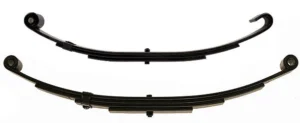
Leaf springs, embodying simplicity and durability, have been a cornerstone in the evolution of vehicle suspension systems. Historically dominant until the 1970s, their design and application have adapted over centuries, from supporting carriages in the mid-17th century to underpinning the heavy loads of modern trucks and industrial equipment. The essence of a leaf spring lies in its arc-shaped steel construction, layered to form a resilient bow-like structure capable of enduring substantial vertical loads while maintaining vehicle stability and alignment.
Key Characteristics and Design:
- Structure: Comprised of arc-shaped thin plates known as leaves, assembled in a fan-like shape with varying widths for optimal flexibility and strength.
- Types: Primarily categorized into lateral and transverse, with lateral springs running the length of the vehicle and mounted perpendicularly to the axle.
- Manufacturing Process: Involves stages like pre-heat treatment, assembly, and surface finishing to ensure durability and performance.
Applications and Advantages:
- Versatility: While their use in passenger vehicles has diminished, leaf springs continue to be vital in trucks, vans, and farming equipment due to their capacity to handle heavy loads.
- Durability and Support: The tight-knit structure and friction between the steel plates offer excellent damping and quick response times after vertical flexes, enhancing the ride quality.
- Cost-Effectiveness: Their simple design and ease of production make leaf springs a cost-effective solution for heavy-duty applications.
Leaf springs exemplify a blend of traditional design and modern engineering, catering to the rigorous demands of heavy-duty vehicles and equipment. Their ability to provide support, absorb road irregularities, and maintain alignment underscores their enduring relevance in the automotive and industrial sectors. As materials and manufacturing processes evolve, leaf springs adapt, ensuring their place in the pantheon of essential mechanical components.
Disc Springs
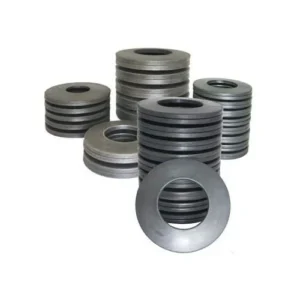
Disc springs, also recognized as Belleville springs, play a pivotal role in a multitude of applications across various industries due to their unique conical shape and ability to withstand heavy loads. These springs are integral in ensuring safety, reliability, and efficiency in machinery and equipment. The following points elaborate on the diverse uses and characteristics of disc springs:
- Key Uses and Characteristics:
- In quick-action stop valves, disc springs prevent complications from liquid or gas leakage by maintaining constant pressure and absorbing set-loss of gaskets, thereby extending the valve’s lifespan.
- They are crucial in securing tools to machine tops, providing consistent mooring pressure which facilitates easy tool release.
- For cable grips and wire cables, disc springs generate a constant clamping force, compensating for any deformations and ensuring secure connections.
- Belleville springs are instrumental in maintaining continuous tension between pieces, preventing bolt loosening which is essential in machinery that experiences vibrations or dynamic loads.
- Within the automotive industry, Belleville disc springs are utilized in applications requiring high force over small deflections, such as in brakes, clutches, and suspension systems.
- Material and Design Considerations:
- Available materials include standard, corrosion-resistant, thermally stable, antimagnetic, high-temperature, and corrosion protection options, catering to the specific requirements of various applications.
- Disc spring stacks are designed to absorb deflections of bearing surfaces, ensuring even movement, which is particularly beneficial in applications like boilers.
- Types of disc springs encompass Belleville Washers, Slotted Disc Springs, Wave Disc Springs, Special Disc Springs, High Performance Generation II Disc Springs, and Self Centering Disc Spring Stacks, each tailored for specific applications and performance needs.
- Selection and Customization:
- For applications with large deflection cycles, DIN 2093-compliant Disc Springs are recommended to ensure reliability and durability.
- When selecting a disc spring, opting for the largest possible size compatible with the desired characteristics is advisable to maximize efficiency and performance.
- Custom Contact Disc Springs are available, adhering to stringent manufacturing and quality control standards, allowing for precise customization to meet exact application requirements.
Disc springs exemplify engineering ingenuity, offering solutions that ensure the safety, efficiency, and reliability of various mechanical systems. Their adaptability, combined with a wide range of available materials and types, makes them an indispensable component in modern engineering applications.
FAQs
What are the primary categories of springs?
The four main types of springs are torsion, extension, spiral, and compression springs. Among these, torsion springs are the most commonly encountered.
Can you explain the different springs and provide an example of their use?
Springs are classified based on the load they are designed to bear. For instance:
- Compression Springs: These springs compress under a load and are commonly found in shock absorbers, retractable pens, and spring mattresses.
- Extension Springs: Operating under tensile load, these springs are typically used in mechanisms like garage door openers.
What are the fundamental roles of springs?
Springs are designed to perform various tasks based on their type, including supporting loads, absorbing shock, and maintaining force or tension in mechanical systems.
What varieties of springs are utilized in Die Mould Engineering (DME)?
In Die Mould Engineering, several types of helical springs are used, including:
- Compression Springs
- Extension Springs
- Torsion Springs
- Spiral Springs
- Elliptical Leaf Spring
- Semi Elliptical Leaf Spring
- Quarter Elliptical Leaf Spring
- Three-Quarter Elliptical Leaf Spring
These springs serve different functions depending on their design and the specific requirements of the mechanical system they are part of.
